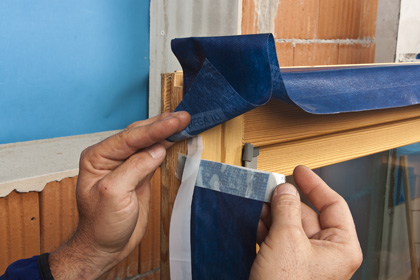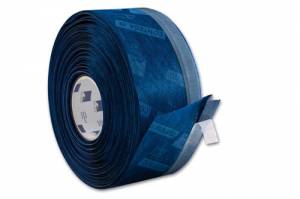Contega IQ
Available in all stores
Conditionnement
en rouleau
Unité de vente
rouleau
CONTEGA IQ
Intelligent window connection tape for indoor and outdoor useAdvantages
- Moisture-variable g-value: Install on windows with the same tape indoors and outdoors
- Vapour retarding and airtight connection of indoor window and door joints in accordance with DIN 4108-7, SIA 180 and OENORM B 8110-2
- Permeable, wind-tight and driving rain resistant connections outdoors
- Especially flexible and soft, can easily be folded to fit into corners
- Can be plastered over on the fleece side
- With expansion joint to allow for structural movement
- Lowest VOC rating in hazardous substance test
Application
Pro clima CONTEGA IQ is used for airtight sealing of windows and doors to the vapour retarder and airtight sealing layer indoors in accordance with DIN 4108-7.
As a result of the intelligent, moisture-variable functional membrane, CONTEGA IQ is also suitable for external windproof and driving rain resistant sealing. The tape is equipped with an expansion joint and can therefore optimally absorb structural movement.
ID 12941 - CONTEGA IQ with 1 self-adhesive strip for application in masonry construction
ID 13016 - CONTEGA IQ with 2 self-adhesive strips for application in timber construction
Technical specs
| Material | |
| Backing | PP fleece and special PP copolymer membrane |
| Adhesive | special acrylate adhesive |
| Attribute | Norm | Value |
| Colour | dark blue | |
| sd-value | EN ISO 12572 | 0.25 - 10 m - humidity variable |
| g-value | 1.25 - 50 MNs/g - humidity variable | |
| Water vapor permeance | ASTM E 96 | 13.12 - 0.33 US perms humidity variable |
| Exposure time | 3 months | |
| RAL quality label | RAL-GZ 711, Fugendichtungskomponenten und -systeme | available |
| Application temperature | above -10 °C / 14 °F | |
| Temperature resistance | permanent -40 °C/-40 °F to +90 °C/194 °F | |
| Storage | cool and dry |
Substrate
Before sticking, subsurfaces should be brushed off, wiped clean with a cloth or cleaned using compressed air.
Adhesion to frozen surfaces is not possible. There must be no water-repellent substances (e.g. grease or silicone) on materials to be bonded. Subsurfaces must be sufficiently dry and have sufficient load-bearing capacity.
Permanent adhesion is achieved on all pro clima interior and exterior membranes, other vapour retarder and airtight membranes (e.g. those made of PE, PA, PP and aluminium) as well as other underlay/sarking and wall lining membranes (e.g. those made of PP and PET).
Adhesion can be carried out on planed and painted wood, hard plastics, hard wood-based panels (chipboard, OSB and plywood panels).
For bonding joints on masonry or concrete or on rough substrates, use ORCON F.
The best results in terms of structural stability are achieved on high-quality subsurfaces.
It is your responsibility to check the suitability of the subsurface; adhesion tests are recommended in certain cases.
Pretreatment with TESCON PRIMER RP is recommended in the case of subsurfaces with insufficient load-bearing capacity.
Limiting factors
The bonds should not be subjected to tensile strain.
Press firmly to secure the adhesive tape. Ensure there is sufficient back-pressure.
Driving rainproof and wind- or airtight seals can only be achieved if this connection tape is laid without folds or creases and are uninterrupted.
Ventilate regularly to prevent build-up of excessive humidity and use a dryer if necessary.
Applications
Face intérieure: CONTEGA IQ est collé avec l’une des bandes autocollantes intégrées sur le chant de l’encadrement de fenêtre (éventuellement à l’intérieur si la fenêtre est déjà placée). Ensuite, une autre bande autocollante sert pour coller sur l’ébrasement de l’ouverture (ossature bois) ou la colle ORCON CLASSIC / F est utilisée pour coller le ruban sur la maçonnerie. Le ruban peut être plafonné.
Face extérieure: Le film étanche CONTEGA est collé sur le chant ou la face extérieure de la menuiserie avec l’une des bandes autocollantes intégrées. Dans la construction à ossature bois, les autres bandes autocollantes intégrées servent à coller sur l’encadrement ou la couche d’isolation (panneau de fibres de bois, écrans de protection de murs) à l’extérieur du mur. Dans la construction massive (brique, brique de béton, …) le ruban est collé avec la colle ORCON sur les joues de l’ouverture, après quoi celui-ci peut être plafonné.
Suivant le type de pose, il est parfois plus simple de coller la bande d’étanchéité à l’air sur l’encadrement de fenêtre avant de placer la fenêtre dans sa baie, sans oublier les oreilles à chaque angle pour permettre le déploiement de la membrane.
Le ruban convient également pour les raccords autour des passages de canalisations rectangulaires à travers la maçonnerie et parois d’ossature bois.
Supports adéquats pour le ruban adhésif :
Un collage durable et étanche est obtenu sur toutes les membranes extérieures pro clima, écrans de sous-toiture ou de protection des murs derrière bardage, ainsi que les membranes PP et PET pour la réalisation de l’étanchéité extérieure. Collages et raccords sont possibles sur le bois raboté ou verni, plastiques ou métaux rigides (par ex tuyaux, fenêtres...), panneaux de dérivés de bois rigides (OSB, agglomérés, multiplex, MDF). Pour coller à la maçonnerie, au béton ou sur des supports rugueux, utiliser ORCON F ou ORCON CLASSIC.
Avant le collage, il convient de nettoyer les supports à l’aide d’une brosse ou de les essuyer avec un chiffon. Le collage sur supports recouverts d’une fine couche de glace n’est pas possible. Les matériaux à coller ne peuvent pas être recouverts de substances anti-adhésives (par ex graisses ou silicone). Ils doivent être suffisamment solides.
Les collages étanches à l’air sont conformes aux normes DIN 4108-7, SIA 180 et ÖnormB8110-2.
Plafonnages adéquats pour le fonctionnement du film :
Tous les enduits de plâtre. Les enduits à la chaux et cimentés doivent disposer d’une armature en mortier.
